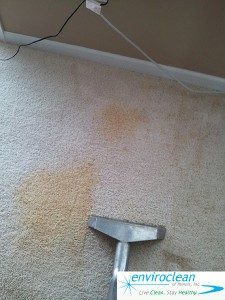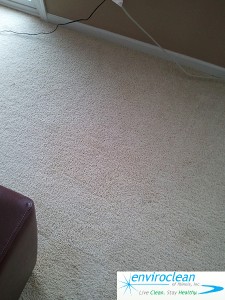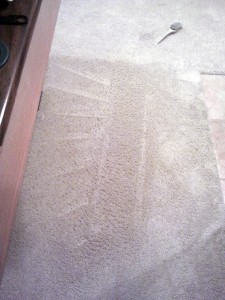We have a wide range of stain treatment / removal services available. The treatment required for removing the stain will depend on the initial cause of the staining, the material composition of the carpeting, and what actions have already been taken to treat the stain. In most cases, we have the ability to apply advanced color modification treatments to remove the color of the carpeting that has been permanently stained and redye the fibers to the original color of the carpeting. This is of course assuming that there are no other treatments available to remove the discoloration.

Before

After

Before

After
Information Regarding Pet Stains on Carpeting
It is not unusual for homeowners who have household pets to have urine stains on their carpeting. Pets will urinate within a home as an act of territorialism, anxiety, or simply out of need.
Mammalian urine is composed of waste products of protein metabolism (uric acid, calcium oxalate, phosphates, and urates), making it both a potential staining agent and a soil attracting agent. The color of pet urine and its staining potential will often depend on dietary habits and the age of the pet. Foods high in protein tend to produce a darker more pungent and acidic urine. Foods higher in carbohydrates such as corn or oats, produce more alkaline urine that is less likely to stain carpeting and does not produce as potent an odor. Typically, because cat diets are richer in protein than dog diets, their urine will produce harsher odors and more likely to cause stains.
Unlike dogs, cats do not urinate for territorialism. This behavioral pattern in male cats is accomplished by spraying. This urine product also contains the male hormone testosterone, which makes it even more pungent than urine. Although spraying is typically done on a vertical surface (such as a couch), it could also conceivably come in contact with the carpeting beneath.
Another consideration is the age of the pet. The older the pet, the more it’s renal function diminishes, thus producing urine that contains more plasma proteins. As a pet ages less uric acephalia is secreted in the urine, and as such it is less likely to stain carpeting; however, it will produce an even stronger odor. In almost all cases, cat urine is the worst perpetrator for pet stains.
The degree of staining from pet urine within carpeting will depend in part on the fiber type and dye method of the carpeting. Solution dyed fibers will be the most resistant to urine stains with olefin providing the greatest stain resistance. In most cases, stains created by urine tend to leave either a red tinge (by adding to the existing color) or a yellow tinge (by reducing existing color). In either case the shift in color is almost always permanent in nature. Although there are some commercially available products designed to remove urine, they are only effective on fresh spots. Neutralizers and deodorizers offer only minimal help in removing urine and urine odors once it has set into the carpeting and padding. Even the subfloor can become contaminated.
Acids found in pet urine can also liberate calcium carbonate fillers used in carpet latex, causing it to lose its bonding strength. Therefore, it is not uncommon to experience delaminating and loss of tuft bind strength in carpet exposed to pet urine.
Urine stains can be identified in several ways, the most obvious means being smell. Pet urine will initially emanate a strong ammonia odor, which after several days develops into a musty odor. This is due to pet urine being very concentrated.
Due to the mineral content of urine, it will fluoresce under a black light. Using litmus indicator paper, pet urine (cat in particular) will display a red (slightly acid) color (pH 6-6 ½). Extractions taken from stained fibers can be tested for the presence of uric acid and creatinine. Staining of the carpet backing is also usually apparent.
Although old urine stains cannot be removed from carpeting unless advanced color modification procedures are implemented by an expert certified cleaning technician, stains that have appeared within a couple of hours can often be cleaned with good success. This can be accomplished by using a 50/50 solution of white vinegar and water, followed by blotting with water only. After this, absorb the spot with clean colorfast towels until it is as dry as possible. Next, place a one-half inch thick weighted layer of colorfast towel over the spot and let it sit overnight. This final procedure must not be overlooked since crystallized urine residues left in the carpet are capable of reproducing odors during the warmer more humid months. Older urine stains often require replacement of the carpet and pad in the affected areas and can also necessitate cleaning the subfloor with a disinfectant.
A final concern for carpet stains from pets is vomit. Hydrochloric acids found in the stomach of pets will be present in any vomitus material. The degree of acidity of these materials and their potential staining of carpeting will be based on stomach content. Foods disgorged from the stomach tend to dilute the hydrochloric acid content, reducing the chance for staining. On the other hand, reflux of bile from the small intestine, which is more common with dogs, can be highly acidic. Typically, stomach acids are very acidic at pH 2, which explains why vomit is much more likely to stain carpet than food. Like urine, the effectiveness of cleaning vomit is based on expediency. The first step is to scrape up as much of the disgorged matter as possible.
Next, it is important to elevate the ph of the stained area. This should be accomplished by blotting using a solution of one part non-sudsing ammonia to five parts water, followed by blotting with a damp towel until the spot is as dry as possible. Again it is also recommended that you place a weighted layer of colorfast towels folded one-half inch thick over the spot and allow it to sit overnight to allow residual matter to wick up into the towel.


